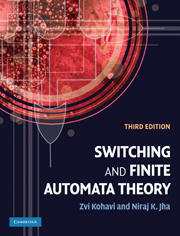Book contents
- Frontmatter
- Contents
- Preface
- Part 1 Preliminaries
- Part 2 Combinational logic
- Part 3 Finite-state machines
- 9 Introduction to synchronous sequential circuits and iterative networks
- 10 Capabilities, minimization, and transformation of sequential machines
- 11 Asynchronous sequential circuits
- 12 Structure of sequential machines
- 13 State-identification experiments and testing of sequential circuits
- 14 Memory, definiteness, and information losslessness of finite automata
- 15 Linear sequential machines
- 16 Finite-state recognizers
- Index
9 - Introduction to synchronous sequential circuits and iterative networks
from Part 3 - Finite-state machines
Published online by Cambridge University Press: 05 June 2012
- Frontmatter
- Contents
- Preface
- Part 1 Preliminaries
- Part 2 Combinational logic
- Part 3 Finite-state machines
- 9 Introduction to synchronous sequential circuits and iterative networks
- 10 Capabilities, minimization, and transformation of sequential machines
- 11 Asynchronous sequential circuits
- 12 Structure of sequential machines
- 13 State-identification experiments and testing of sequential circuits
- 14 Memory, definiteness, and information losslessness of finite automata
- 15 Linear sequential machines
- 16 Finite-state recognizers
- Index
Summary
In Part 2 we considered combinational switching circuits in which the output values are functions of only the current circuit input values. In most digital systems, however, additional circuits are necessary that are capable of storing information and data and also of performing some logical or mathematical operations upon this data. The output values of these circuits at any given time are functions of external input values as well as of the stored information at that time. Such circuits are called sequential circuits.
A finite-state machine (or finite automaton) is an abstract model describing the synchronous sequential machine and its spatial counterpart, the iterative network. It is the basis for the understanding and development of the various computation structures discussed in Part 3 of this book. The behavior, capabilities, limitations, and structure of finite-state machines are studied in Chapters 12 through 16, while Chapters 9 and 10 are devoted to the synthesis of these machines. Chapter 11 is concerned with asynchronous sequential circuits.
Sequential circuits – introductory example
In our daily activities, we all encounter the use of various sequential circuits. The elevator control which “remembers” to let us out before it picks up people coming into elevator; traffic-light systems on our roads, trains, and subways; the lock on a safe that not only remembers the combination numbers but also their sequence; all these are examples of sequential circuits in action. Before deriving the basic model and general synthesis procedures, we shall investigate the properties of a simple sequential circuit.
Information
- Type
- Chapter
- Information
- Switching and Finite Automata Theory , pp. 265 - 306Publisher: Cambridge University PressPrint publication year: 2009
